History
PARI is located at the site of the former Rosman Satellite Tracking Station, which was established by the National Aeronautics and Space Administration (NASA) in 1962. The site was part of the worldwide Spacecraft Tracking and Data Acquisition Network and an integral communications link for the crewed space programs Project Gemini and Project Apollo.
The facility was transferred to the National Security Agency (NSA) in 1981. Known as the Rosman Research Station, it was used as a signals intelligence gathering facility. The site was closed by the NSA in 1995 and transferred to the United States Forest Service. [1]
After several years of inactivity, the federal government proposed to dismantle the facility. Recognizing the utility of the site, a small group of interested scientists and businessmen formed a not-for-profit foundation, which acquired the site in January 1999. It has continued capital investment at the facility, enabling updates of the equipment for astronomical observation purposes. A staff of professional astronomers, engineers, and other scientists work at the observatory.
In the early morning hours of Dec 24th, 2012, the institute was burglarized. Its collection of about 100 meteorites, valued at at least $80,000 and with specimens weighing up to 80 pounds (36 kg), was stolen, along with about $100,000 worth of TVs, monitors, projectors, microscopes, and other scientific equipment. [2] Much of the stolen property, including the meteorite collection, was recovered within a week. [3]
Timeline of telescopes, observatories, and observing technology.

Lowell Observatory is an astronomical observatory in Flagstaff, Arizona, United States. Lowell Observatory was established in 1894, placing it among the oldest observatories in the United States, and was designated a National Historic Landmark in 1965. In 2011, the Observatory was named one of "The World's 100 Most Important Places" by Time Magazine. It was at the Lowell Observatory that the dwarf planet Pluto was discovered in 1930 by Clyde Tombaugh.
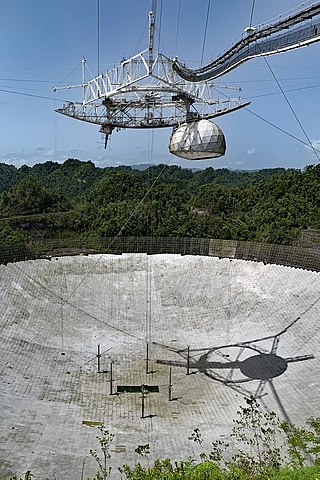
The Arecibo Observatory, also known as the National Astronomy and Ionosphere Center (NAIC) and formerly known as the Arecibo Ionosphere Observatory, is an observatory in Barrio Esperanza, Arecibo, Puerto Rico owned by the US National Science Foundation (NSF).

Photographic plates preceded photographic film as a capture medium in photography. The light-sensitive emulsion of silver salts was coated on a glass plate, typically thinner than common window glass. They were heavily used in the late 19th century and declined through the 20th. They were still used in some communities until the late 20th century.

Yerkes Observatory is an astronomical observatory located in Williams Bay, Wisconsin, United States. The observatory was operated by the University of Chicago Department of Astronomy and Astrophysics from its founding in 1897 until 2018. Ownership was transferred to the non-profit Yerkes Future Foundation (YFF) in May 2020, which began millions of dollars of restoration and renovation of the historic building and grounds. Yerkes re-opened for public tours and programming in May 2022. The April 2024 issue of National Geographic magazine featured a story about the Observatory and ongoing work to restore it to relevance for astronomy, public science engagement and exploring big ideas through art, science, culture and landscape. The observatory offers tickets to programs and tours on its website.
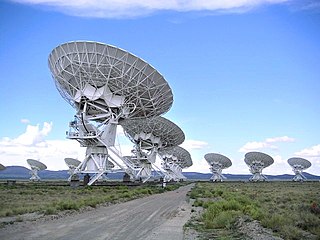
The National Radio Astronomy Observatory (NRAO) is a federally funded research and development center of the United States National Science Foundation operated under cooperative agreement by Associated Universities, Inc. for the purpose of radio astronomy. NRAO designs, builds, and operates its own high-sensitivity radio telescopes for use by scientists around the world.
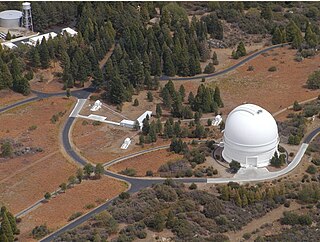
Palomar Observatory is an astronomical research observatory in the Palomar Mountains of San Diego County, California, United States. It is owned and operated by the California Institute of Technology (Caltech). Research time at the observatory is granted to Caltech and its research partners, which include the Jet Propulsion Laboratory (JPL), Yale University, and the National Astronomical Observatories of China.

The Haleakalā Observatory, also known as the Haleakalā High Altitude Observatory Site, is Hawaii's first astronomical research observatory. It is located on the island of Maui and is owned by the Institute for Astronomy of the University of Hawaiʻi, which operates some of the facilities on the site and leases portions to other organizations. Tenants include the Air Force Research Laboratory (AFRL) and the Las Cumbres Observatory Global Telescope Network (LCOGTN). At over 3,050 meters (10,010 ft) in altitude, the summit of Haleakalā is above one third of the Earths's troposphere and has excellent astronomical seeing conditions.

The Indian Astronomical Observatory (IAO) is a high-altitude astronomy station located in Hanle, India and operated by the Indian Institute of Astrophysics. Situated in the Western Himalayas at an elevation of 4,500 meters (14,764 ft), the IAO is one of the world's highest located sites for optical, infrared and gamma-ray telescopes. It is currently the tenth highest optical telescope in the world.

Konkoly Observatory is an astronomical observatory located in Budapest, Hungary is part of the Research Centre for Astronomy and Earth Sciences and belongs to the HUN-REN Magyar Kutatási Hálózat. Konkoly Observatory was founded in 1871 by Hungarian astronomer Miklós Konkoly-Thege (1842–1916) as a private observatory, and was donated to the state in 1899. Konkoly Observatory, officially known as HUN-REN CSFK Konkoly Thege Miklós Csillagászati Intézet in Hungarian, is the largest astronomical research institute in Hungary, and hosts the largest telescopes in the country. The Observatory has more than 60 researchers, a quarter of them are non-Hungarian.

The Royal Observatory, Edinburgh (ROE) is an astronomical institution located on Blackford Hill in Edinburgh. The site is owned by the Science and Technology Facilities Council (STFC). The ROE comprises the UK Astronomy Technology Centre (UK ATC) of STFC, the Institute for Astronomy of the School of Physics and Astronomy of the University of Edinburgh, and the ROE Visitor Centre.

Associated Universities, Inc. (AUI) is a research management corporation that builds and operates facilities for the research community. It is a not-for-profit 501(c)(3) corporation headquartered in Washington, D.C., United States. The current president is Adam Cohen. The corporation's major current operating unit is the National Radio Astronomy Observatory, which it operates under a Cooperative Agreement with the National Science Foundation.
The US National Virtual Observatory'-NVO- was conceived to allow scientists to access data from multiple astronomical observatories, including ground and space-based facilities, through a single portal. Originally, the National Science Foundation (NSF) funded the information technology research that created the basic NVO infrastructure through a multi-organization collaborative effort. The NVO was more than a “digital library”; it was a vibrant, growing online research facility akin to a bricks-and-mortar observatory for professional astronomers.

Las Cumbres Observatory (LCO) is a network of astronomical observatories run by a non-profit private operating foundation directed by the technologist Wayne Rosing. Its offices are in Goleta, California. The telescopes are located at both northern and southern hemisphere sites distributed in longitude around the Earth. For some astronomical objects, the longitudinal spacing of telescopes allows continuous observations over 24 hours or longer. The operating network currently consists of two 2 meter telescopes, nine 1 meter telescopes, and seven 40 cm telescopes, placed at six astronomical observatories. The network operates as a single, integrated, observing facility, using a software scheduler that continuously optimizes the planned observing schedule of each individual telescope.

The University of Illinois Astronomical Observatory, located at 901 S. Mathews Avenue in Urbana, Illinois, on the campus of the University of Illinois Urbana–Champaign, was built in 1896, and was designed by Charles A. Gunn. It was listed on the National Register of Historic Places on November 6, 1986, and on December 20, 1989, was designated a National Historic Landmark.

Helsinki University Observatory housed the Department of Astronomy at the University of Helsinki, south Finland until end of 2009. It is now an astronomy-themed visitor centre and museum.

The National Astronomical Research Institute of Thailand, or NARIT, is a research institute under the Ministry of Higher Education, Science, Research and Innovation. NARIT's headquarters are in Chiang Mai, Thailand. The main missions of the institute are to carry out, support, and promote the development of astronomy and astrophysics in Thailand through research, public outreach, and educational activities.
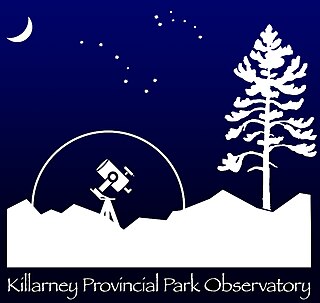
The Killarney Provincial Park Observatory is an astronomical observatory located at the George Lake Campground of Killarney Provincial Park . The Observatory is operated by Ontario Parks and houses two observatory buildings. The original facility contains a 10" telescope with solar filter, ideal for nighttime as well as daytime viewing of the Sun. The newer facility contains a 16" fully automated telescope with a 5" refractor and is ideal for research, astrophotography and public use. The telescopes are available for Discovery programs as well as private sign-out (self-use) by interested visitors.
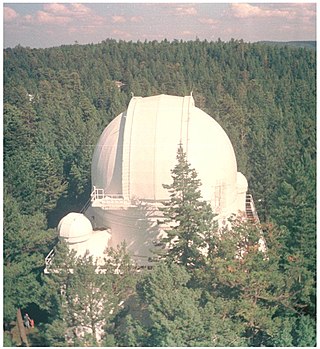
Cloudcroft Observatory, is an astronomical observatory located in the Lincoln National Forest near Cloudcroft, New Mexico, approximately 23 kilometers (14 mi) northeast of Alamogordo. It is owned by the Tzec Maun Foundation, a private astronomical organization.

The Green Bank Observatory is an astronomical observatory located in the National Radio Quiet Zone in Green Bank, West Virginia, U.S. It is the operator of the Robert C. Byrd Green Bank Telescope, the world's largest fully steerable radio telescope.






























